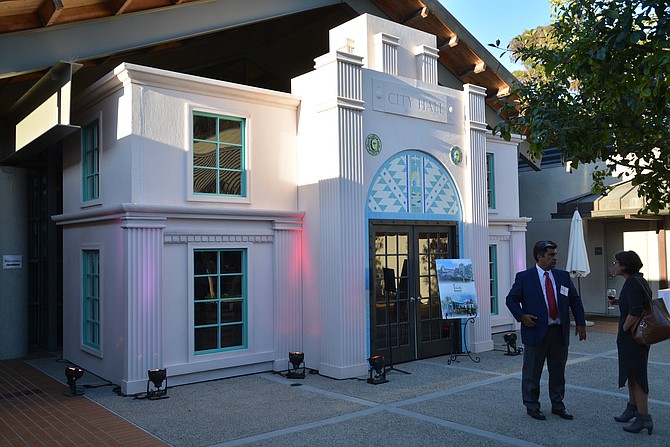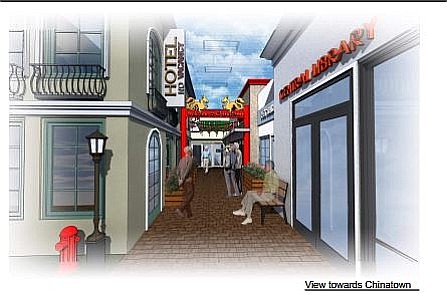 Facebook
Facebook
 X
X
 Instagram
Instagram
 TikTok
TikTok
 Youtube
Youtube

The Glenner Center is breaking ground on a new kind of adult day-care center that could help change the way patients with Alzheimer’s and dementia are treated and also to prepare for what CEO Scott Tarde calls the “silver tsunami” heading our way.
“The numbers are incredible,” said Tarde. “There are 60,000 San Diegans diagnosed with Alzheimer’s and that’s expected to grow to 90,000 in the next 10 to 15 years.”
Glenner Center is a nonprofit that was founded by George Glenner, a pioneer in Alzheimer’s research. He opened the first of three centers in 1982 on the heels of a frantic call from a husband overwhelmed by caring for his wife with Alzheimer’s.
Slated to open in early 2018, the day-care will utilize a 1950/1960s-era “town square” to complement memory therapy that uses cues from the past to improve a patient’s mental health. The facility will be housed within a 15,000-square-foot industrial building in Chula Vista.
Tarde gave a glimpse of one of the planned 23 storefronts on September 14 at a UCSD reception. Tarde said the “city hall” unveiled at the reception is a smaller version of what will be installed at the actual center.
The Chula Vista Town Square will serve as a beta-test site for transmuting the same "reminiscent therapy" the center has used since the beginning.
“The idea came about after my 11-year-old daughter came home raving about her visit to BizTown [a model city providing hands-on business experience for children],” said Tarde. “I went to check it out around November 2015 and that’s where the spark started.”
Tarde explained the reason for the 1950s timeframe.

“Our strongest memories are from 15 to 35 years old and since most of our participants are in their 80s, most of them were in their mid-20s or early-30s in the 1950s or 1960s. The patients have fond memories of this time, so when they go into a physical space from that time, they should be able to more easily retrieve memories.”
Storefronts will include a library, school house, hotel, restaurant, grocery store, fitness center, department store, pet shop, hardware store, beauty salon, art and music studio, and sports pub with a half-basketball court.
There is also talk of a jazz club in the future as well as changing with the times. “Hopefully we won’t need it by then, but the storefronts could be designed and changed to accommodate a different era such as the 1980s.”
How will the therapy work?
“We envision taking seniors through a structured day like they had in their life at that time,” said Tarde. “We might start off in the café and read about current events while drinking coffee and then move into the office building and do some structured activities, then onto the museum, then lunch at the diner, and then maybe see a movie. The exciting thing is there are endless combinations and each storefront has any number of activities that can be done. When patients go home at the end of the day, they will have had a rich, full day.”
The center recently acquired a 1955 jukebox and a 1959 T-bird that patients will be able to tinker with at a garage storefront. As far as the movie theater, all films will be from 1953 to 1961.
When the idea was first being discussed, a Glenner boardmember asked Tarde who he knew in “show biz” to build the “sets.” After a Google search, he found that San Diego Opera’s Scenic Studios had not only built opera sets for more than 40 years, but also sets for museums, corporate events, Comic-Con, and rock bands.
David Bennett, San Diego Opera’s general director, said inspiration for the Glenner storefronts came from old photographs and drawings of actual buildings from 1950s and early-1960s San Diego. The storefronts are made to assemble, break down, and store easily.
Tarde said the budget for Glenner’s Town Square is $3 million. There will be fundraising events likely in the first week of December and in March 2017 to coincide with the center’s 35th anniversary. A crowdfunding page has also been set up.
Fundraising events will be posted on Facebook.


The Glenner Center is breaking ground on a new kind of adult day-care center that could help change the way patients with Alzheimer’s and dementia are treated and also to prepare for what CEO Scott Tarde calls the “silver tsunami” heading our way.
“The numbers are incredible,” said Tarde. “There are 60,000 San Diegans diagnosed with Alzheimer’s and that’s expected to grow to 90,000 in the next 10 to 15 years.”
Glenner Center is a nonprofit that was founded by George Glenner, a pioneer in Alzheimer’s research. He opened the first of three centers in 1982 on the heels of a frantic call from a husband overwhelmed by caring for his wife with Alzheimer’s.
Slated to open in early 2018, the day-care will utilize a 1950/1960s-era “town square” to complement memory therapy that uses cues from the past to improve a patient’s mental health. The facility will be housed within a 15,000-square-foot industrial building in Chula Vista.
Tarde gave a glimpse of one of the planned 23 storefronts on September 14 at a UCSD reception. Tarde said the “city hall” unveiled at the reception is a smaller version of what will be installed at the actual center.
The Chula Vista Town Square will serve as a beta-test site for transmuting the same "reminiscent therapy" the center has used since the beginning.
“The idea came about after my 11-year-old daughter came home raving about her visit to BizTown [a model city providing hands-on business experience for children],” said Tarde. “I went to check it out around November 2015 and that’s where the spark started.”
Tarde explained the reason for the 1950s timeframe.

“Our strongest memories are from 15 to 35 years old and since most of our participants are in their 80s, most of them were in their mid-20s or early-30s in the 1950s or 1960s. The patients have fond memories of this time, so when they go into a physical space from that time, they should be able to more easily retrieve memories.”
Storefronts will include a library, school house, hotel, restaurant, grocery store, fitness center, department store, pet shop, hardware store, beauty salon, art and music studio, and sports pub with a half-basketball court.
There is also talk of a jazz club in the future as well as changing with the times. “Hopefully we won’t need it by then, but the storefronts could be designed and changed to accommodate a different era such as the 1980s.”
How will the therapy work?
“We envision taking seniors through a structured day like they had in their life at that time,” said Tarde. “We might start off in the café and read about current events while drinking coffee and then move into the office building and do some structured activities, then onto the museum, then lunch at the diner, and then maybe see a movie. The exciting thing is there are endless combinations and each storefront has any number of activities that can be done. When patients go home at the end of the day, they will have had a rich, full day.”
The center recently acquired a 1955 jukebox and a 1959 T-bird that patients will be able to tinker with at a garage storefront. As far as the movie theater, all films will be from 1953 to 1961.
When the idea was first being discussed, a Glenner boardmember asked Tarde who he knew in “show biz” to build the “sets.” After a Google search, he found that San Diego Opera’s Scenic Studios had not only built opera sets for more than 40 years, but also sets for museums, corporate events, Comic-Con, and rock bands.
David Bennett, San Diego Opera’s general director, said inspiration for the Glenner storefronts came from old photographs and drawings of actual buildings from 1950s and early-1960s San Diego. The storefronts are made to assemble, break down, and store easily.
Tarde said the budget for Glenner’s Town Square is $3 million. There will be fundraising events likely in the first week of December and in March 2017 to coincide with the center’s 35th anniversary. A crowdfunding page has also been set up.
Fundraising events will be posted on Facebook.
Comments